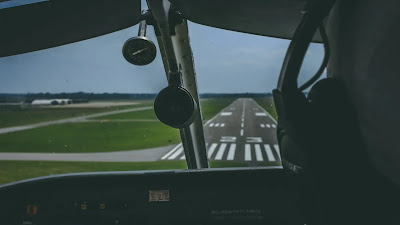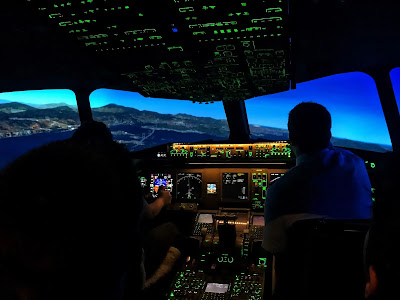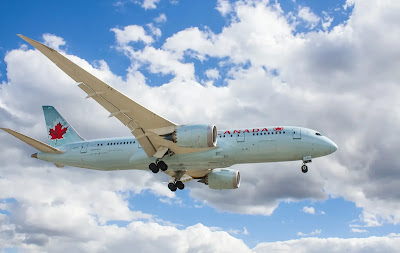An Air Canada crj-100 ER was traveling on Air Canada Flight 646 on December 16, 1997, from Pearson International Airport in Toronto, Canada, to Fredericton International Airport in New Brunswick, Canada. 42 passengers, including two children, were traveling on the aircraft.
The first officer was flying on this particular day, and he was in for some pretty terrible news. Although the weather in Fredericton was ideal, the landing would only be visible for an eighth of a mile. Even with the lights turned all the way up, the runway would still be quite difficult to see. However, because they have been taught to handle situations like this, pilots shouldn't have any trouble.
The pilots turned the plane over to the autopilot as they made an eyeless approach to Runway 1-5 at Fredericton. The pilots in the cockpit were trying to see through the fog to catch a peek of the runway as the plane cut through the dense fog and night. The pilot then noticed the glow of the runway through the fog as soon as the aircraft was only 300 feet above the ground.
They were forced to turn around once they arrived at the decision height. In a cat 3 approach, you may essentially land blind. In this case, however, they were not, so if they had not seen the runway light, they would have had to circle the airport at a distance of 165 feet. As the first officer struggled to get the jet back on glide, the captain became apprehensive. To get the plane back on the glide slope, the first officer turned off the engines.
Remember that the plane was just 80 feet above the ground at the time all of this was happening. The pilot suddenly realized that the aircraft was too much to the left of the extended center line and that he had no idea where they were on the runway. The captain decided to order a go-around because this landing was no longer feasible.
Talk about the courage displayed by the Flight 646 passengers and crew.
A few seconds later, the first officer acknowledged the go-around after accelerating the engines to maximum power and selecting the go-round option from the flight director. The jet was very close to stalling when the shaker went off, leaving the pilots with little time to rescue the aircraft. They had no idea why the aircraft was so near to stalling; normally, they should be climbing away and gaining speed. The captain ordered flaps and a go-around.
The stall safety system was activated by a tone played in the cockpit, but the plane had already begun to stall and the pilots were helpless to stop it. The jet leveled out before heading back toward the runway with a 20-degree right bank before it crashed. Except for the emergency lighting, the plane's electrical power failed as it dragged down the runway.
It deviated to the right after the intersection of the two runways, cut through a snowbank, and continued for an additional 1,000 feet until coming to a rest next to a snowy hill. Thankfully, everyone on board—including the infants—made it out alive. The Transport Safety Board, or TSB, was tasked with determining what went wrong as soon as the investigation got underway because, in the end, we had a landing that went catastrophically wrong.
The accident's primary cause was the weather. It was snowing, gloomy, and foggy—a lethal mix.
According to all accounts, this landing was very near to being impossible due to the weather since the RVR, or runway visual range, was 1200 feet, the absolute minimum required to complete a landing. This indicated that the crew's decision to continue the landing was the appropriate one because they could see the runway lights and the weather was just about in their favor.
The truth is, even if Canada had a more lax stance for tackling inclement weather than most other nations, this exact method would have been completely unacceptable in many other nations. The ILS approach at Fredericton was a category one approach, which made the situation worse. This meant that neither the runway's center line illumination nor the touchdown zone lighting was necessary, nor was the captain required to pilot the aircraft.
The first officer presumably had a harder time keeping the plane in glide and aligned with the runway because there was no centerline lighting and no lighting in the touchdown zone. The pilot would have been able to land with the aid of everything I just outlined, but they were not available at the airport at the time. You can see where this is headed if you add the bad weather to the mix.
The Things We Can Learn From This Experience
The PMA, or pilot monitored approach, method was used at a time when there was a lot of demand on the pilot flying other airlines. With this method, one pilot flies the approach on instruments while the other pilot keeps an eye out for visual clues for landing, such as the runway. If the pilot gazing out sees the runway, he or she assumes control and makes the landing while the other pilot continues to keep an eye on the instruments.
It crashed. The data revealed an intriguing fact: the pilots unintentionally put this jet in a situation it had never been in before, not even during testing. The pilots chose not to proceed with the landing; instead, they attempted a go-around, which is typically successful. When the plane was very close to the ground, the first officer turned down the engines, which put it in an energetic state that prevented a go-around without striking the ground. Then there is the flight director.
The first officer may have contributed to this tragedy by focusing solely on the flight director and failing to see other cues in the cockpit warning that the aircraft were moving dangerously slowly. The weather they were flying through was suitable for ice, but the protocols in use at the time did not call for the employment of any ice devices.
Therefore, according to the investigators, when the plane approached 1000 feet above the ground, it entered an area of icing, where very minute amounts of ice began to accumulate on the wing, reducing its performance slightly. As a result, when the first officer unintentionally put the aircraft in low-energy mode for a go-around The play needed every bit of performance it could muster, but sadly, the somewhat iced-over wings further reduced the wing's effectiveness, leaving the plane with little choice but to crash.
The policies in place at the time, the first officer's relative inexperience, a tiny quantity of ice, and the procedures in place at the time eventually contributed to this tragedy. What are your thoughts on such an evaluation? In your opinion?






_11zon.png)

No comments:
Post a Comment